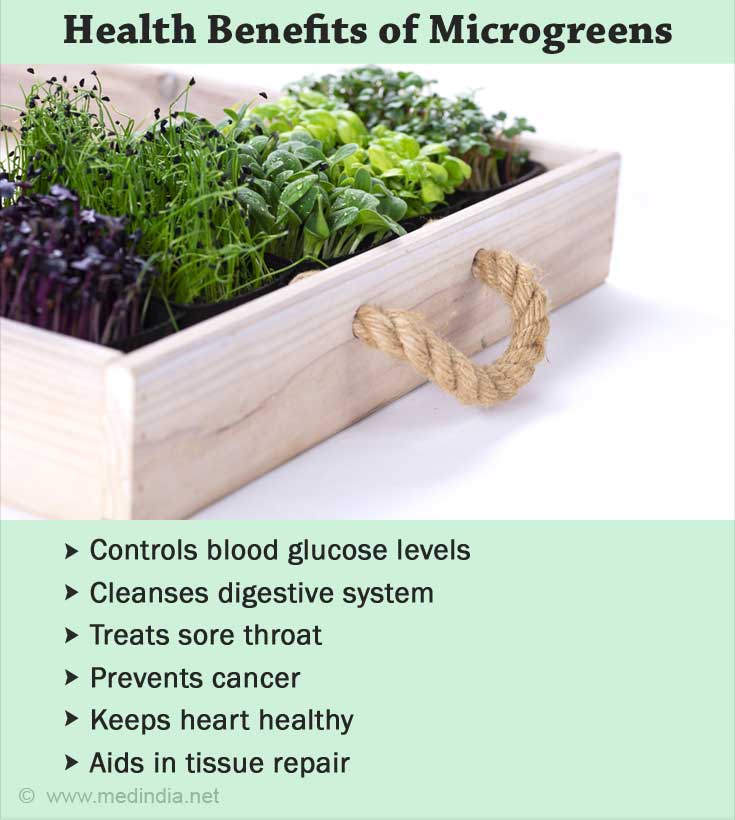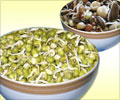- Renna, M., & Paradiso, V. M. (2020). Ongoing research on microgreens:Nutritional properties, shelf-life, sustainable production, innovative growing and processing approaches. Foods (Basel, Switzerland),9(6), 826 - (https://doi.org/10.3390/foods9060826)
- A Step-By-Step Guide for Growing Microgreens at Home - (https://extension.psu.edu/a-step-by-step-guide-for-growing-microgreens-at-home)
- Ojha, S.,Rajguru, S., & Chavan, S.(2021). Microgreens: A multimineral superfood.FASJ, 2(04), 118 - (https://fasj.org/index.php/fasj/article/view/90)
- Zhang, Y., Xiao, Z., Ager, E., Kong, L., & Tan, L. (2021). Nutritional quality and health benefits of microgreens, a crop of modern agriculture.Journal of Future Foods, 1(1), 58-66. ISSN 2772-5669 - (https://doi.org/10.1016/j.jfutfo.2021.07.001)
- Turner, E. R., Luo, Y.,& Buchanan, R. L. (2020). Microgreen nutrition, food safety, and shelf life: A review. Journal of Food Science, 85, 870-882 - (https://doi.org/10.1111/1750-3841.15049)
- Organic Microgreens - (https://www.manage.gov.in/publications/knowledgeseries/microgreens.pdf)
What are Microgreens?
Microgreens are edible, tender, young, or juvenile vegetable greens that are harvested once the cotyledonary leaves develop and the first true leaves pop up. They are considered potential functional foods due to their rich nutritional background and are also substituted for sprouts for their flavor, texture, and taste.
Microgreens can be grown indoors and outdoors, as they are space-friendly and easy to grow. The only obstacle for cultivators with microgreens is that they are tender, delicate and have a short shelf life.
Microgreens hold a macro-level nutritional profile and exhibit several health benefits. They are rich in phytochemicals like phenolic compounds and carotenoids, vitamins like vitamin C, and minerals like zinc and copper.
The popularly used microgreens include: cabbage, broccoli, mustard, radish, kale, buckwheat, cucumber, mint, chia, basil, fenugreek, sweetpea, lettuce, spinach, onions, garlic, fennel, parsley, wheatgrass, and many more.
How to Grow Microgreens?
Growing microgreens at home are becoming popular in urban homes. Nutrition experts, vegans, vegetarians, and raw-foodists turn heads to microgreens for the different varieties of microgreens that can be easily grown. It can be grown in kitchen gardens, workstations, window panes, and even in back yards.
The items needed are microgreens seeds, neutral or slightly acidic water or drinking water, growing containers, and growing medium (like a soil-peatmix, coconutcoir, synthetic fibers, hempmat, or cottonmat). The growing containers or tray should have draining holes at the bottom to drain off excess water. The growing medium of choice should be filled in the tray.
Fill another tray without holes with water and slowly place the bottom of the growing trays into the water to wet the soil for the microgreens seeds to stick better to the soil. Drain the excess water once wet enough. Next, distribute enough microgreens seeds over the soil. Non-hybrid, open-pollinated heirloom, and GMO-free microgreen seeds are ideal for growing. It is not necessary to cover the seeds with soil. Some seeds will require prior treatments like overnight soaking to stimulate germination.
After seeding, spraying water occasionally to maintain moisture is necessary. Keeping them in the dark for a few days is suggested to facilitate germination. For some seeds like peas and sunflower shoots, placing a weight on top will maintain the seed’s contact with soil and will help the shoots to de-hull its seeds from cotyledons.
Once the seedlings have popped out, ensure adequate light (either natural or artificial) and water. If the first true leaves have emerged, the microgreens are ready to be harvested. The total period between germination and harvesting is 7 to 14 days for most species.
What are the Health Benefits of Microgreens?
Microgreens can be considered functional foods and superfoods owing to their great health benefits. Hence, they can be called ‘functional superfoods.’ They possess anti-inflammatory, antioxidant, antimicrobial, anti-cancer, anti-diabetic properties, and many more.

Control Blood Glucose Levels: Studies have shown microgreens to be beneficial in controlling blood sugar and in weight management. Fenugreek microgreens have been studied to compress the activity of the enzyme that is responsible for producing glucose and aids in managing blood glucose levels.
Antioxidant properties: The vitamin C, carotenoids, and isothiocyanates content of mustard microgreens benefit as antiproliferative and antioxidants. The bioaccessibility of bioactive compounds polyphenols and glucosinolates in kohlrabi and kale microgreens enables them to exert anti-inflammatory, antimicrobial, anti-diabetic, and anti-carcinogenic properties. Radish microgreens are good sources of vitamin C, antioxidants that help cleanse the digestive system, treat sore throat and cold.
Anti-cancer properties: Microgreens that display anti-cancer properties are broccoli, chickpeas, buckwheat, flax, mustard, and rutabaga microgreens.
Heart health: Fenugreek microgreens are sources of fiber and complex carbohydrates, thereby, aiding in digestive disorders, heart health, menstrual health, and regulating cholesterol levels. Animal studies have reported that red cabbage microgreens powder supplementation regulates cholesterol levels by reducing LDL (low–density lipoprotein) cholesterol levels and hepatic triglyceride levels. Moringa and beet microgreens can help control blood pressure. Moring a microgreens also aid in weight management and lowering cholesterol levels.
Tissue repair: Wheat grass is rich in chlorophyll (70%) and is a good choice for body builders. Sunflower microgreens are high in essential amino acids and help in the repair of tissues. The important bioactive compounds, tocopherol, phenolics, ascorbic acid, phylloquinone, minerals (like calcium, iron, manganese, magnesium, zinc, and selenium), and vitamins (like vitamins A, K, E), are present in higher proportions in microgreens than their mature ones.
Recipes
Microgreens have shone their light in the culinary world for their unique flavor, texture, vibrant color, and taste. Wheat microgreens or wheat grass juice is a healthy and wide-known recipe.
Microgreens can be added to salads, sandwiches, burgers, soups, and desserts. It can also be used to make smoothies and as an ingredient in dhal and wraps. However, consuming microgreens raw can help retain the nutrients and flavor.

Nutritional Facts of Microgreens
Microgreens being packed with nutrients like minerals and vitamins can aid in boosting immunity and fighting chronic diseases, and preventing and treating nutritional deficiencies.
- The vitaminC content in microgreens ranges from 29.9 to 123.2 mg/100g fresh weight (FW). Jute and cucumber microgreens have been shown to contain a vitamin C content of about 17.45 mg/100 g FW and 10.00 mg/100 g FW, respectively. In general, the vitamin C content in microgreens is higher than the mature ones.
- Antioxidant minerals such as zinc are found in ranges between 4.76 mg/kg FW and 29.12 mg/kg FW. Small legumes like alfalfa, zigzag clover has 0.6 to 3.2 times higher zinc content when compared to raw seeds and sprouted seeds.
- The carotenoid content in wheat was 53.36 mg/100g dry weight and in barley 56.08 mg/100g dry weight. The carotenoid content of wheat and barley showed an increase 16 days after sowing.
- Broccoli has a good amount of polyphenol content of about3.63 mcg/g FW.
- Anthocyanin is found to be in higher amounts in mustard microgreens (405.53 mcg/g FW).
- Microgreens are a great source of beta-carotene as well (redcabbage-11.5 mg/100g FW).
Nature has its own beauty and so do microgreens. These tiny greens have a massive nutritional background, vibrant color, fresh taste, and an array of health benefits. The rich bioactive compounds present in microgreens speak for the extensive research and health benefits they exert.







